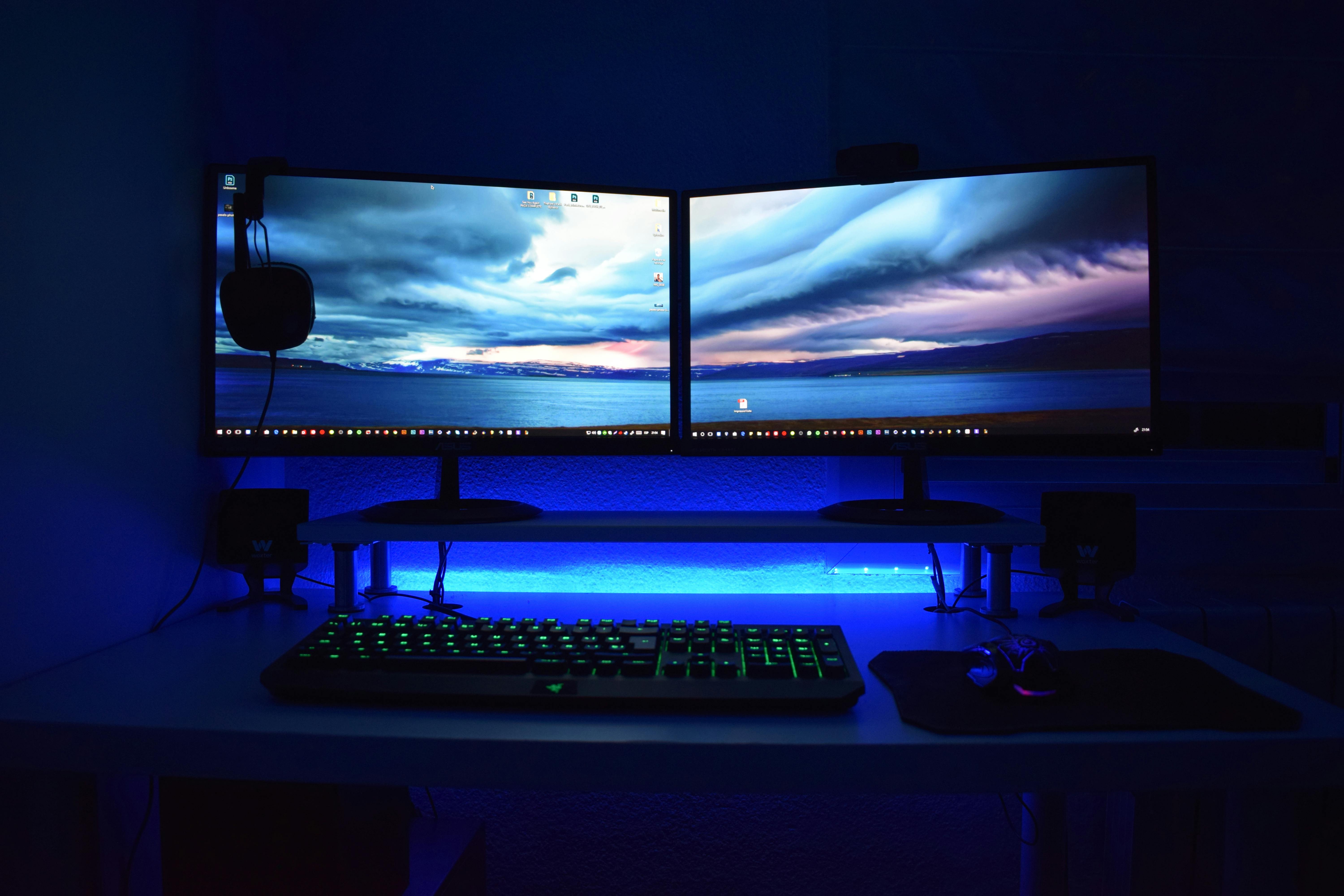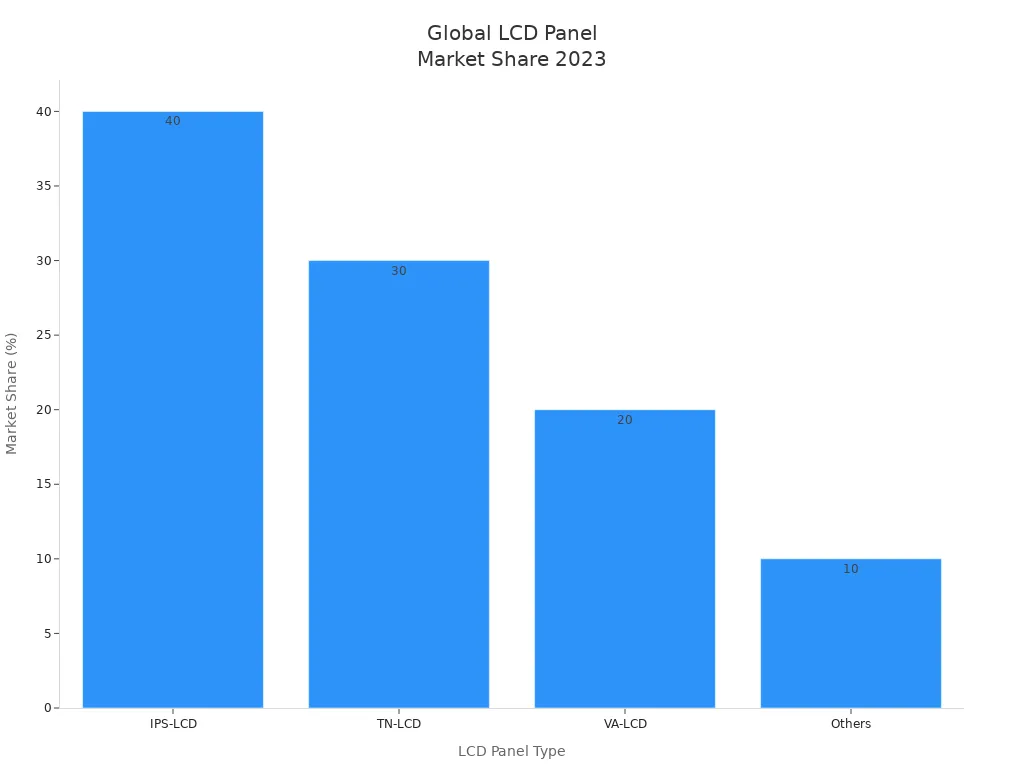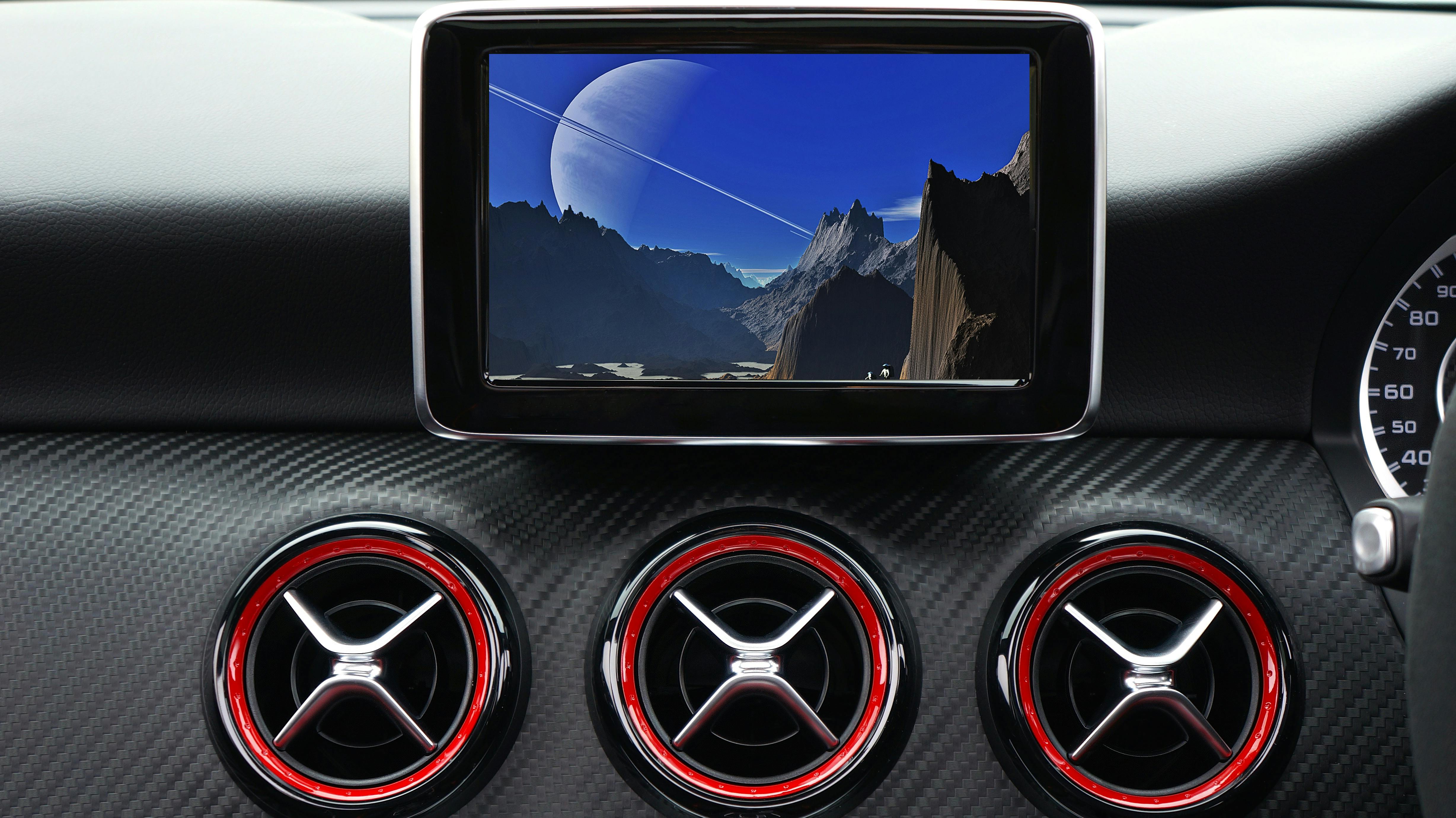How LCD Technology Works and Why It Matters
LCD technology powers much of the world’s visual information. This technology uses a layer of liquid crystals, a backlight, and color filters to control light and create images. LCD displays do not emit light themselves but rely on the backlight shining through the liquid crystal layer. The combination of these elements allows the display to show vibrant colors and sharp images. Today, LCD displays appear in televisions, smartphones, monitors, and public infrastructure. People see them every day in transport stations and digital billboards because of their reliability and clarity. LCD technology remains the leading display technology globally, holding nearly half of the electronic display market according to recent studies.

Data source:https://electroiq.com/stats/display-technology-statistics/
Key Takeaways
LCD technology uses liquid crystals and a backlight to create bright, colorful images without emitting light itself.
Key LCD components like polarizers, liquid crystals, and TFT arrays work together to control light and produce sharp, clear displays.
Different LCD panel types (TN, IPS, VA, LTPS) offer unique benefits for gaming, professional work, and general use based on color, contrast, and speed.
Compared to OLED and MicroLED, LCDs remain popular due to their durability, lower cost, and energy efficiency with bright content.
Proper care, such as gentle cleaning and avoiding static images, helps extend the life and performance of LCD screens.
LCD Technology Basics

Source:pexels
What Is a Liquid Crystal Display?
A liquid crystal display, often called an LCD, is a flat-panel display technology that uses the unique properties of liquid crystals to control light and create images. LCD technology has become the foundation for many modern devices, including televisions, computer monitors, smartphones, and digital clocks. This technology does not emit light directly. Instead, it relies on a backlight that shines through layers of materials, including liquid crystals, to produce visible images.
Liquid crystals used in LCDs are special organic molecules with elongated shapes. These molecules have regions that encourage organized alignment. Their structure includes planar benzene rings and polar end groups, which help them interact in a controlled way. Physically, these molecules show anisotropy and birefringence. This means they can split light into two polarized rays that travel at different speeds. These properties are essential for the optical behavior of LCD displays. The twisted nematic effect, discovered in 1969, allows these molecules to rotate polarized light by 90 degrees. This effect is the basis for how LCDs control light and form images.
LCD technology has evolved to meet the demands of modern users. Manufacturers design liquid crystals with low viscosity for fast response and low threshold voltage for energy efficiency. These advances help LCD displays deliver sharp images, vibrant colors, and reliable performance in a wide range of environments.
Structure and Components
LCD displays use a layered structure to achieve high image quality and energy efficiency. Each layer plays a specific role in the operation of the display. The main components include:
Backlight Module: Provides uniform illumination since the liquid crystals do not emit light. Modern LCDs often use LED backlights for better energy efficiency.
Polarizer Films: Control the direction and polarization of light, which is crucial for modulating brightness and contrast.
Glass Substrates: Sandwich the liquid crystal layer and provide structural support, ensuring panel integrity and image uniformity.
Transparent Electrodes (ITO): Apply voltage to the liquid crystals, enabling precise control of each pixel.
Liquid Crystal Layer: Modulates light by twisting or aligning in response to voltage, directly affecting image sharpness and contrast.
Color Filter Layer: Divides each pixel into red, green, and blue sub-pixels, allowing accurate color reproduction.
TFT Array: Controls voltage at each pixel quickly and precisely, improving response time and image clarity.
Alignment Layers: Ensure the uniform orientation of liquid crystals, preventing visual artifacts.
Spacer Beads: Maintain a consistent gap between glass substrates, ensuring even distribution of liquid crystals.
Rear Polarizer: Works with the front polarizer to enhance contrast and image clarity.
Note: The combination of these components creates a thin, lightweight, and energy-efficient display technology that delivers vivid images and stable performance.
Component | Function and Contribution to Image Quality and Energy Efficiency |
|---|---|
Polarizer Films | Control light polarization, essential for modulating light and achieving proper contrast and brightness. |
Glass Substrates | Provide structural support ensuring panel integrity and uniformity, which prevents image distortion. |
Color Filter Layer | Filters light into red, green, and blue sub-pixels, crucial for accurate color reproduction and fidelity. |
Transparent Electrodes (ITO) | Apply voltage to liquid crystals precisely, enabling pixel-level control for sharp images and efficient operation. |
Liquid Crystal Layer | Modulates light by twisting or aligning in response to voltage, controlling pixel brightness and contrast. |
TFT Array | Controls voltage at each pixel rapidly and accurately, improving image sharpness, response time, and reducing power waste. |
Alignment Layers | Ensure uniform orientation of liquid crystals, preventing visual artifacts and maintaining consistent image quality. |
Spacer Beads | Maintain uniform cell gap for even liquid crystal distribution, avoiding light leakage and image non-uniformity. |
Rear Polarizer | Works with front polarizer to enhance contrast and image clarity. |
Backlight Module | Provides uniform, energy-efficient illumination (often LED-based), critical for brightness and reducing power consumption. |
Working Principles
LCD technology operates by controlling the passage of light through the liquid crystal layer. The process begins with a bright backlight that emits unpolarized light. This light first passes through a horizontal polarizing filter, which only allows light waves vibrating in one direction.
The liquid crystal molecules, arranged in a twisted nematic structure, rotate the polarization of the light by 90 degrees when no electric field is present. The light then passes through a vertical polarizing filter. If the liquid crystals rotate the light, it passes through the second filter, and the pixel appears bright. When an electric field is applied, the molecules align with the field, lose their twist, and no longer rotate the light. The vertical polarizer then blocks the light, making the pixel appear dark.
This switching mechanism allows each pixel to be turned on or off by controlling the orientation of the liquid crystal molecules. By adjusting the voltage at each pixel, the display can create a full range of colors and shades. The TFT array ensures rapid and precise voltage control, which results in sharp images and smooth motion.

Data source:https://www.verifiedmarketreports.com/product/lcd-display-panel-market/
LCD displays have become the dominant display technology worldwide. IPS-LCD panels hold the largest market share due to their superior color accuracy and wide viewing angles. TN-LCD panels remain popular for their fast response times and cost-effectiveness, especially in gaming and budget displays. VA-LCD panels are favored for their high contrast ratios and are the fastest-growing segment.
LCD technology continues to advance, offering reliable performance, energy efficiency, and high-quality images. Manufacturers optimize each component to ensure that LCD displays meet the needs of consumers in various applications, from personal electronics to large public displays.
Types of LCD Displays

Source:pexels
Passive and Active Matrix
LCD displays use two main methods to control pixels: passive matrix and active matrix. Each method affects image quality, response time, and cost.
Active matrix LCDs use thin-film transistors (TFTs) to control each pixel. This design delivers sharper images, fast response times, and wide viewing angles. Users see vibrant colors and stable images, even during fast motion. Active matrix displays appear in most modern devices, such as smartphones, monitors, and televisions.
Passive matrix LCDs use a grid of electrodes without individual transistors. This method results in lower image quality, slower response times, and narrow viewing angles. These displays work well in basic devices like calculators and digital clocks, where high resolution and clarity are less important.
Performance Aspect | Active Matrix LCDs | Passive Matrix LCDs |
|---|---|---|
Pixel Control | Each pixel controlled by its own TFT | Pixels controlled by row and column intersections |
Image Quality | Sharper, vibrant images, better contrast | Lower image quality, limited contrast |
Response Time | Fast, reduces motion blur | Slower, causes ghosting |
Viewing Angles | Wide, consistent | Narrow, image degrades off-center |
Power Consumption | Higher, especially for dynamic content | Lower for static images |
Resolution and Clarity | Supports high resolution and clarity | Limited resolution and clarity |
Applications | Smartphones, monitors, televisions | Calculators, clocks, simple displays |
TN, IPS, VA, LTPS Panels
LCD displays come in several panel types, each with unique advantages for color, contrast, and viewing experience.
Panel Type | Color Accuracy and Contrast | Response Time | Viewing Angles |
|---|---|---|---|
TN | Limited color accuracy, lower contrast | Fastest | Narrow, color shifts |
IPS | Slower than TN | Very wide, stable | |
VA | Excellent contrast, deep blacks | Slower than TN | Wider than TN, less than IPS |
LTPS | Dynamic, rich colors, strong contrast | Fast, high performance | N/A (used in TFT LCDs) |
TN panels offer the fastest response times, making them ideal for gaming. IPS panels provide the best color accuracy and wide viewing angles, which benefit professional design and multimedia. VA panels excel in contrast and deep blacks, suitable for mixed usage. LTPS technology enables high resolution and clarity, often used in advanced mobile displays.
Choosing the Right LCD
Selecting the right LCD depends on the intended application. For gaming, a display with a TN panel offers fast response and high refresh rates. Professional designers and content creators benefit from IPS panels due to their color accuracy and wide viewing angles. VA panels suit users who want strong contrast for movies and general use. Mobile devices often use LTPS technology for high resolution and clarity.
Other factors include resolution and clarity, brightness, and power consumption. High resolution improves detail for tasks like video editing or immersive entertainment. Brightness matters for outdoor use or HDR content. Lower brightness can save power and reduce eye strain indoors. Touch integration, such as capacitive or resistive touch, also plays a role in device usability. Each type of display technology brings unique advantages, allowing users to match the LCD to their needs.
LCD vs Other Display Technologies

Source:pexels
LCD vs OLED
When comparing display technologies, LCD vs LED often causes confusion. Most modern LED displays actually use LCD panels with LED backlighting. True LED displays refer to organic light emitting diode (OLED) or MicroLed screens. LED technology uses organic materials that emit light when powered. Each pixel in an OLED display produces its own light, which allows for deep blacks and high contrast. In contrast, LCD displays rely on a backlight that shines through liquid crystals and color filters.
Parameter | LCD | OLED |
|---|---|---|
Lifespan | Generally longer, often over 100,000 hours; more durable and reliable | Shorter lifespan due to organic material degradation; especially blue diodes degrade faster |
Power Consumption | More efficient with bright or white content due to backlight usage | More energy-efficient with dark or black content as pixels can be turned off individually |
Cost | Typically lower cost; more cost-effective and durable | Higher production cost due to complex manufacturing and expensive materials; price gap narrowing |
OLED displays offer excellent contrast and vibrant colors. However, LCD displays provide greater durability and cost advantages. The organic light emitting diode materials in OLED panels degrade over time, especially the blue diodes, which can affect clarity and color balance. LCD screens maintain consistent performance and reliability for longer periods. OLED displays save energy when showing dark images, while LCD displays perform better with bright or white content.
LCD vs MicroLED
MicroLED displays represent a new generation of display technology. Each pixel in a MicroLED display emits its own light, similar to OLED, but uses inorganic materials. This design delivers higher brightness, deeper blacks, and superior contrast. MicroLED displays also achieve excellent color accuracy and energy efficiency. However, manufacturing MicroLED displays remains complex and costly. Producers must transfer millions of tiny LEDs with precision, which limits commercial availability to premium markets.
Feature | MicroLED (LED) Displays | LCD Displays |
|---|---|---|
Backlighting Method | Pixels emit own light (self-emissive) | Requires backlight (LED or CCFL) |
Picture Quality | Higher brightness, deeper blacks, better contrast and color | Good color reproduction but lower brightness and contrast |
Energy Efficiency | More energy-efficient due to direct emission | Less efficient due to backlight |
Commercial Usage | Targeted at high-end, premium markets due to cost and complexity | Widely used in affordable consumer and commercial products |
LCD vs LED comparisons often highlight the affordability and versatility of LCD displays. LCD technology benefits from mature manufacturing, making it accessible for a wide range of applications.
Why LCD Remains Popular
LCD displays continue to dominate the global market for several reasons:
Strong demand for smart home devices and connected displays.
Integration of voice assistants and smart features in LCD vs LED products.
Advancements in AI and IoT enhance display technology and user interaction.
Streaming services and multimedia drive the need for high-resolution LCD displays.
LCD displays offer energy efficiency, clarity, and attractive designs.
Consumers prefer larger, high-definition screens, especially for entertainment and remote work.
LCD technology remains affordable and adaptable, supporting rapid growth in emerging markets.
Note: LCD displays hold a significant share of the display technology market due to their advantages in cost, reliability, and versatility. As smart technologies and high-resolution content become more common, LCD vs LED displays will continue to meet the needs of both consumers and industries.
LCD Applications and Care

Source:pexels
Everyday Applications
LCD technology appears in many areas of daily life. People use LCD screens in smartphones, televisions, and computer monitors. The automotive industry relies on LCD displays for digital instrument clusters, infotainment systems, and heads-up displays. Industrial sectors use LCD panels in control rooms, factory automation, and medical equipment. The applications of lcd have expanded as technology has improved, offering color, touch, and flexible display options.
Application Area | Examples and Trends |
|---|---|
Consumer Electronics | Smartphones, tablets, TVs, monitors, digital cameras, smartwatches |
Automotive | Instrument clusters, infotainment, HUDs, rear-seat entertainment, EV dashboards |
Industrial/Commercial | Factory controls, medical monitors, public information displays, POS terminals |
Historical Use | Digital clocks, odometers, basic info displays (monochrome, low-res) |
Market Trends | Larger screens, touch integration, high adoption in Asia-Pacific and North America |
The applications of different display technologies continue to grow, but LCD remains dominant due to its versatility and reliability.
Care and Maintenance Tips
Proper care extends the lifespan and performance of LCD screens. Users should follow these best practices:
Clean the screen regularly with a soft, lint-free cloth and a mild LCD cleaner.
Avoid pressing or tapping the display with sharp objects to prevent damage.
Adjust brightness and contrast to comfortable levels to reduce energy use.
Prevent static images from staying on the screen for long periods by using screen savers.
Keep the device within recommended temperature ranges.
Use surge protectors to guard against power spikes.
Follow the manufacturer's maintenance guidelines for optimal results.
Avoid direct sunlight and UV exposure to prevent color fading.
Maintain good air quality and control humidity to avoid condensation.
Ensure proper ventilation to prevent overheating.
Update firmware and recalibrate the display for accurate colors.
Turn off the screen when not in use to prevent image retention.
Tip: Regular maintenance and mindful usage help LCD technology deliver reliable performance for years.
BOE LCD Technology in Education and Industry
BOE's LCD technology brings significant advantages to both education and industry. In classrooms, the BOE classroom-screen solution uses advanced quantum dot technology to produce vibrant images and a wide color gamut. Blue light reduction and adaptive brightness features protect students' eyes and support visual comfort during long lessons. Teachers benefit from accurate color reproduction, which helps present scientific diagrams and art projects more clearly. These features enhance student engagement and improve learning outcomes.
In industrial and commercial applications, BOE LCD panels offer large format sizes, high resolutions up to 16K, and high refresh rates for smooth visuals. The technology supports wide viewing angles and anti-glare surfaces, making displays easy to read in different lighting conditions. BOE designs its panels for durability, low power consumption, and eco-friendly manufacturing. These advantages make BOE LCDs suitable for demanding environments, such as control rooms, medical facilities, and public information displays.
Advantage Category | Details |
|---|---|
Display Sizes | 65" to 110"+, suitable for large venues |
Resolution | 4K, 8K, up to 16K for detailed images |
Refresh Rates | Up to 600Hz for smooth motion |
Viewing Angle | Nearly 180°, consistent image quality |
Surface Treatments | Anti-glare, anti-reflection options |
Power Efficiency | Low power use, eco-friendly materials |
Durability | Robust design, operates from -30°C to +80°C, long lifespan |
BOE integrates AI-powered features and smart sensing to further improve display performance and efficiency. These innovations support a wide range of applications of lcd, from education to industry, and highlight the ongoing value of lcd technology.
LCD Manufacturing Process
Steps of LCD Manufacturing
Manufacturers follow a precise sequence of steps to produce high-quality LCD panels. Each stage plays a vital role in ensuring the final product meets strict standards for performance and reliability.
Glass Substrate Preparation: Workers clean, polish, and shape the glass substrate. This step removes contaminants and ensures a flat surface, which prevents distortions in the display.
Thin Film Transistor (TFT) Fabrication: Engineers create electronic switches on the glass. These transistors control each pixel, directly affecting how the panel performs.
Color Filter Application: Technicians use photolithography to apply color filters. This process ensures accurate color reproduction and long-lasting durability.
Liquid Crystal Cell Assembly: Specialists align the glass substrates and fill the cell with liquid crystal fluid. They use spacers to maintain a uniform gap, which is critical for clarity and brightness.
Vacuum Liquid Crystal Injection and End Sealing: The cell undergoes vacuum injection to remove air and moisture, then receives a UV-curable resin seal. This step prevents leaks and contamination, which supports a long lifespan.
Automatic Polarizer Attachment: Machines align and attach polarizers. Proper alignment controls light passage and affects brightness and color accuracy.
Module Assembly (Pinning): Workers integrate the backlight, driver circuits, and protective frames. Precise alignment ensures both electrical and mechanical stability.
Quality Assurance and Testing: The panel undergoes electrical, optical, and environmental tests. These checks verify performance, reliability, and visual quality.
Packaging and Shipping: Staff use protective materials and proper labeling to prevent damage during transit.
Note: Cleanroom environments and automated production lines help prevent contamination and increase consistency throughout the process.
Innovations from China LCD Manufacture
Chinese manufacturers, especially BOE, have introduced major advancements in display technology. BOE’s factories use advanced automation and AI-driven defect detection to improve both efficiency and product quality. The company’s research and development teams have created flexible OLED displays, transparent panels, and high-refresh-rate screens. At global events, BOE has showcased innovations like a 110-inch 16K glasses-free 3D display and flexible curved screens for vehicles.
BOE’s integration of AI in manufacturing allows real-time monitoring and rapid defect correction. The company also uses CMOS technology to optimize circuitry, which reduces power consumption and improves driving capability. Adaptive refresh rate and oxide semiconductor displays further enhance energy efficiency. These innovations support sustainable and efficient production, meeting the growing demand for high-performance displays.
Innovation Area | Description | Impact on Manufacturing Efficiency and Product Quality |
|---|---|---|
AI + Manufacturing | Large-scale AI model for display industry | Enhances R&D, production management, and operational services |
AI Defect and Yield Management | AI systems detect and locate tiny defects | Improves defect detection, boosting efficiency and quality |
CMOS Technology | Optimized circuitry using CMOS | Reduces power use, improves driving capability |
Adaptive Refresh Rate & Oxide Semiconductor | Dynamic refresh rates and new materials | Lowers power consumption, supports sustainability |
BOE’s commitment to innovation and quality has positioned it as a global leader in display technology, driving the industry forward with new materials, smarter processes, and higher standards.
LCD technology continues to shape modern electronics with its adaptability, cost-effectiveness, and long lifespan. Users benefit from wide viewing angles, high brightness, and reliable performance in both consumer and industrial settings. Understanding lcd structure, panel types, and care helps users make informed choices. BOE and China’s manufacturers drive innovation, ensuring lcd remains competitive as oled advances. The future of display technology will see lcd and oled coexist, with lcd evolving through quantum dots, enhanced durability, and integration with AI. Readers should watch for new trends as lcd adapts to changing needs.
FAQ
What is the main difference between LCD and OLED?
OLED uses organic materials that emit light directly from each pixel. LCD relies on a backlight, often using LED technology. OLED offers deeper blacks and higher contrast. LCD provides longer lifespan and cost advantages. Many users choose between OLED and LCD based on their needs.
Why do most LED displays actually use LCD technology?
Most led displays on the market use LCD panels with led backlighting. The term "led displays" often refers to this combination. True led displays, such as OLED or MicroLED, use self-emissive pixels. LCD with led backlight remains popular for affordability and reliability.
How does OLED improve image quality compared to traditional LED displays?
OLED creates images by lighting up each pixel individually. This allows for perfect blacks and vibrant colors. Traditional led displays with LCD panels cannot turn off individual pixels. OLED technology delivers better contrast and more lifelike visuals, especially in dark scenes.
Are OLED screens more energy-efficient than LED displays?
OLED screens save energy when displaying dark images because pixels can turn off completely. Led displays with LCD panels use a constant backlight, which consumes more power. OLED offers efficiency benefits in many scenarios, especially for devices that show a lot of black content.
Can OLED replace all LED displays in the future?
OLED continues to advance and offers many benefits. However, led displays with LCD panels remain important due to their durability, lower cost, and wide availability. OLED may not replace all led displays soon, but it will likely grow in high-end markets.
See Also
Understanding LTPO Technology For Better Battery And Smooth Displays
Exploring UB Cell Technology In Modern Display Screens
Key Features To Look For In A Gaming Monitor